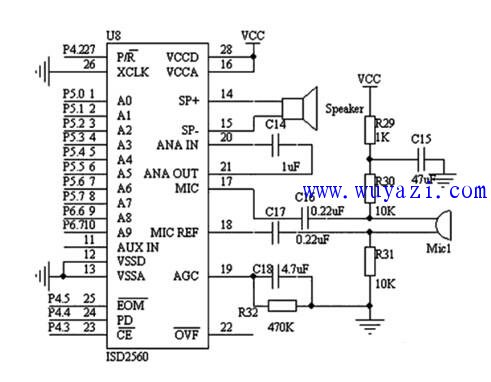Blood glucose test circuit analysis: To detect the number of free electrons produced by the reaction between glucose oxidase and glucose, a fixed bias voltage must be applied across the electrodes. This allows the current generated by the bias voltage to drive the free electrons, which is then used to calculate the blood glucose mass concentration. The required bias voltage varies depending on the chemical materials used on the test strip. In this design, the bias voltage is derived from the VLL1 pin of the liquid crystal drive module through a resistor divider network. The resulting voltage is approximately 273mV. The current generated by the reaction of normal human blood with glucose oxidase typically ranges from nanoamps to microamps. To convert this small current into a measurable voltage, a signal conversion and amplification circuit is necessary.
Figure 2 illustrates an amplifier circuit implemented using the comparator module of the LL16 chip. The positive input of the comparator is connected to a 273mV bias voltage, which is obtained by dividing the VLL1 voltage from the LCD module using three resistors: R6, R5, and R4. A filter capacitor, C4, is included to remove high-frequency noise from the VLL1 supply, ensuring a stable bias voltage. The negative input of the comparator is connected to the enzyme electrode of the test strip, specifically the fourth pin. The free electrons on the electrode flow directionally under the influence of the bias voltage, effectively creating a resistance Rx. The lower the resistance value of Rx, the higher the blood sugar concentration. By measuring the equivalent resistance, the blood glucose mass concentration can be calculated.

In-depth data analysis: The resistance of the test resistor Rx ranges from 18kΩ to 300kΩ. The minimum voltage of the 3V battery is around 2.3V. To ensure that the comparator's maximum output does not exceed the battery’s minimum voltage, the gain of the amplifier circuit must be limited. Choosing R3 as 120kΩ ensures that when the tested resistance is 18kΩ, the output voltage of the amplifier is 2.1V, which remains below the battery’s minimum voltage.
Since the core component of the amplifying circuit is a comparator, the output is a square wave signal. To reduce high-frequency harmonics, a first-order low-pass filter consisting of resistor R1 and capacitor C1 is placed at the comparator's output. This helps smooth out the square wave into a more stable DC signal. However, R1 should not be too large to prevent the comparator output from exceeding its positive limit, but it also shouldn’t be too small for effective filtering. A moderate value of 15kΩ was chosen. For optimal high-frequency noise reduction, C1 should not be too small, but if it’s too large, it could cause excessive amplitude on the negative side of the comparator. After testing, a 1μF capacitor provided the best overall performance.
Although the R1-C1 filter reduces some of the comparator’s output noise, the signal at the positive end of C1 still contains high-frequency ripples. To improve accuracy and consistency in blood glucose measurement, a second stage of filtering is applied using R2 and C2. Considering the optimal frequency range of capacitors, C2 was set to 10μF and R2 to 10kΩ. This dual-stage filtering ensures that the final signal is clean and reliable for accurate blood glucose readings.
60V20Ah Lithium Ion Battery,Waterproof Battery Pack For Bicycle,60V 20Ah L-Ion Waterproof Battery,Rechargeable 60V Lifepo4 Lithium Battery
Jiangsu Zhitai New Energy Technology Co.,Ltd , https://www.zttall.com